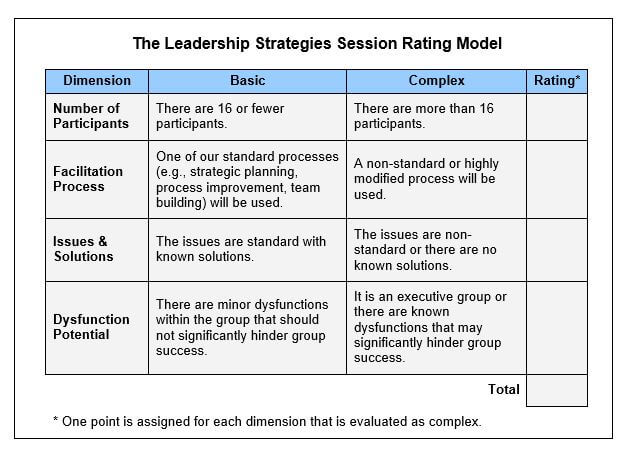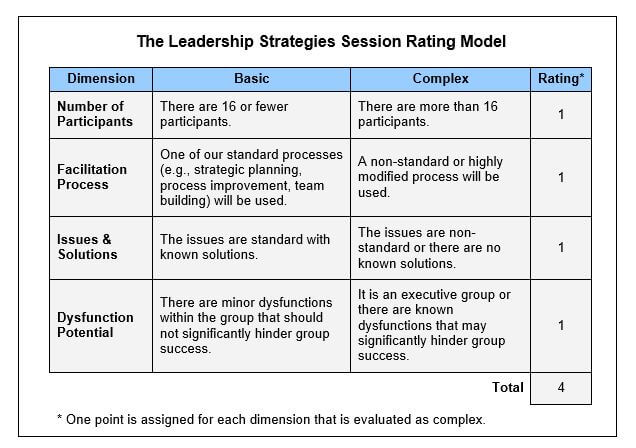At Leadership Strategies, our client relationship managers work hard to match facilitators with the specific needs and budget constraints of our clients. While some sessions are fairly basic and can be handled by our facilitator specialists, other sessions are more complex and require a more seasoned professional. Some sessions are so complex with the stakes so high, that they require not one – but two – of our most senior facilitators. Like our client relationship managers, you must be able to assess when a session is highly complex in order to adequately prepare for it. How difficult is your upcoming session? Do you know if your upcoming session calls for one or more meeting facilitators?
The following rating model provides a guide for determining the difficulty of a session. The model uses four dimensions and defines basic versus complex conditions for each dimension. One point is assigned whenever a dimension is complex.

Translating the Rating
Based on the rating, we recommend the following guidelines for assigning facilitators.
| Rating | Recommendation |
| 0 | All Facilitator Skill-Levels |
| 1 | Intermediate or Senior Facilitator |
| 2 | Senior Facilitator |
| 3-4 | Two Senior Facilitators |
As you can see from the model, a session that has three or more of the complex characteristics requires two senior facilitators. While one is facilitating the group, the other is carefully observing group dynamics and considering changes to the process to maximize the group’s performance. Level 3 and 4 sessions can turn volatile quite quickly, and without a second facilitator, the session can rapidly get out of hand as the example below demonstrates.
An Example
Over my twenty-plus years as a facilitator, I estimate that I have personally led well over 500 facilitated sessions. Over that time, there are three sessions in particular that I wish I could do over – or at least had the Staples “Easy” button!
In this particular session, which occurred before we adopted the rating system, I was facilitating a highly volatile community and political issue. This major urban area was being fined $20,000 a day by their state’s environmental protection department for exceeding the limits of a restricted substance in the treated waste water the city was returning to the waterway. The city treated water from three treatment plants. After an extensive study, the city concluded that it would be significantly more cost effective and politically expedient to upgrade only one of the three treatment plants and build tunnels to transport the waste water from the other two plants.
The one plant that was chosen to be upgraded was located in a predominately African-American community. The tunneling and the size of the upgrade required to accommodate the processing from all the plants would have a significant impact on this community. The two other plants, located coincidentally in Caucasian communities, would be minimally impact. As you can imagine, this plan was met with significant outcry. Activists in the African-American community insisted that no tunneling be done and that instead each plant be upgraded.
To address the outcry, the mayor of the city named a panel of approximately 20, which included citizens from each community as well as engineers and city planners. They gave the team a facilitator (me) and a deadline for reaching consensus on an alternative to either tunneling or upgrading all plants. Tensions were high, and trust was low. So, to keep the process open, the city televised the meetings over cable and permitted an audience to sit through the proceedings.
It was a circus! It was overwhelming trying to manage the session, the process, the committee, the audience, the charts, and so on. At one point, two of the citizen members would have come to fists had it not been for my swiftly stepping in as the distance between them had closed to a couple of feet.
I was in way over my head and didn’t know why (at the time).
Knowing what I know now, here is how I would have scored the difficulty model for that session.

I was alone trying to handle a Level 4 session! Knowing what I know now about rating sessions in advance, there should have been two of our top facilitators working together to help the panel achieve its end.
By the way, the panel did reach consensus – but not to the mayor’s liking. The panel members all agreed that there were no solutions that would satisfy all interests and that the mayor would have to make the decision!
Don’t learn the hard way like I did. Learn more critical group facilitation practices like this through our flagship course, The Effective Facilitator. This course provides a comprehensive, structured approach plus over 100 techniques for leading groups toward better results.
For a condensed, two-day meeting facilitation training, contact us about Facilitating Masterful Meetings – the course where you will learn a proven framework for preparing for, executing, and closing successful meetings.
About the Author
Michael Wilkinson is the CEO and Managing Director of Leadership Strategies, the largest provider of professional facilitators and facilitation training in the country. Michael is a much sought after trainer, facilitator and speaker. He is a Certified Master Facilitator and a Certified Professional Facilitator. As a past president of the Southeast Association of Facilitators, the creator of the FindaFacilitator.com database and a board member of the International Institute of Facilitation, Michael is a national leader in the facilitation industry. You can get more tips from Michael’s books, including The Executive Guide to Facilitating Strategy, The Secrets of Facilitation, The Secrets to Masterful Meetings, and CLICK: The Virtual Meetings Book.

